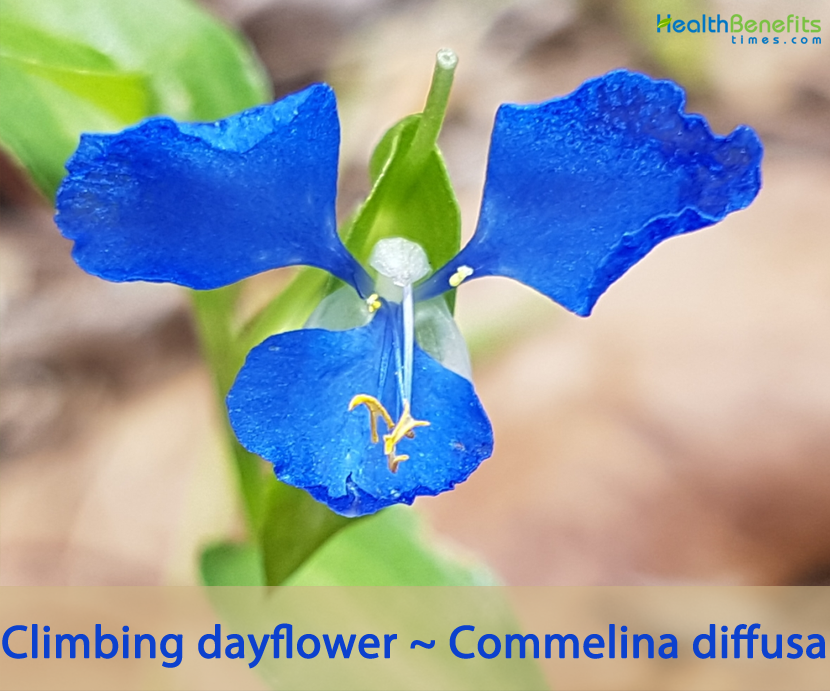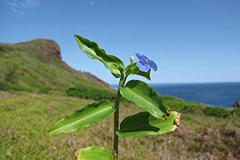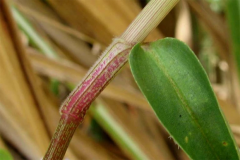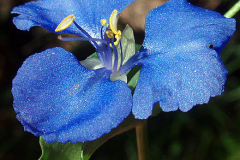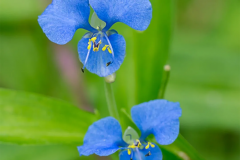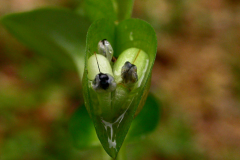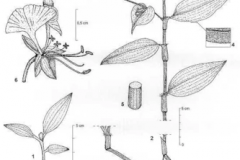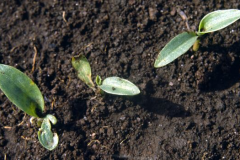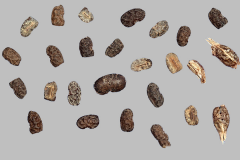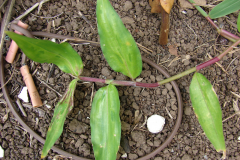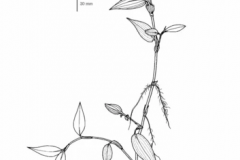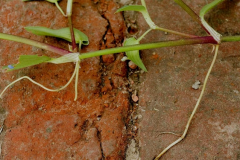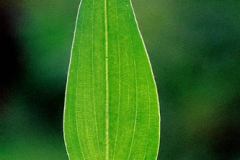| Climbing dayflower Quick Facts | |
|---|---|
| Name: | Climbing dayflower |
| Scientific Name: | Commelina diffusa |
| Origin | Tropical America and the Caribbean, USA, tropical and subtropical Africa, India, Pakistan, China, Southeast Asia, Indonesia, Australia and the Pacific Islands |
| Colors | Initially green turning to pale brown as they ripen |
| Shapes | Small capsules which measures 4 -6.3 mm long and 3 - 4 mm wide, though it may be as narrow as 2.1 mm |
| Taste | Bitter, sweet |
| Health benefits | Support burns, itches, boils, fevers, gonorrhea, dysmenorrhea, abscesses, buboes, headache, irritated uterus, laryngitis, leprosy, malaria, mumps, otitis media, painful menses, pharyngitis, rheumatoid arthritis, sore throats, snake bites, tonsillitis, and tumors |
| Name | Climbing dayflower |
|---|---|
| Scientific Name | Commelina diffusa |
| Native | Tropical America and the Caribbean, USA, tropical and subtropical Africa, India, Pakistan, China, Southeast Asia, Indonesia, Australia and the Pacific Islands. In China, specifically in the provinces of Guangdong, southwestern Guangxi, southwestern Guizhou, Hainan, southeastern Xizang and southeastern Yunnan |
| Common Names | Climbing dayflower, Spreading dayflower, Birdbill Dayflower, Creeping Day Flower, Common dayflower, Creeping-Spiderwort, Creeping Spiderwort, Water grass, French weed, Canutillo, Honohono grass, baby dayflower, commelina, day-flower, native wandering Jew, scurvy weed, pond grass |
| Name in Other Languages | Arabic: وعلان منتشر Assamese: Kona-shimolu Bambara: Nkɛɛrɛnworo Bengali: Citrapatrī (চিত্রপত্রী), Manaina, Kanainala Chamorro: Semprebiban-damalong Chinese: Jie jie cao (節節草), Zhú zǐ cài (竹仔菜), Zhu jie cai, Zhu jie huo, Jie hie cao, Di fang Chuukese: Pwa Comorian: Itswamli, Nrambantsi, Coha Creoles and pidgins: Petite herbe d’eau, Herbe Cochon feuille mince Kiraj, Zèb gra Créole Maurice: Herbe de l’eau, Petite herbe cochon, Herbe d’eau Créole Reunion: Traînasse, Petite herbe de l’eau, Herbe cochon Créole Seychelles: Lerb koson, Herbe cochon Cuba: Canutillo English: Climbing dayflower, creeping-spiderwort, dayflower, spreading dayflower, wandering Jew, watergrass, Birdbill Dayflower, Creeping Day Flower, common dayflower, honohono, baby dayflower, French weed, pond grass, water grass Fijian: Ai rogorogo, ai rongorongo, ai rorongi, cobulabula, drano, duludauwere, kabocola, luna, matembulambula, ndrano, ndulundauwere, rongomatailevu, rorogo, tho nggalonggalo, thombulambula, wa cobocola Finnish: Mattosoljo French: Curage, herbe grasse, herbe de l’eau, mashangu Hawaiian: Honohono, honohono wai, mākolokolo, Honohono grass Hindi: Kankana, Kanshura Ifugao: Bangar-na-lalake Iloko: Kolasi Indonesian: Brangbangan, gewor lalakina, awarang Japanese: Shima-tsuyu-kusa (シマツユクサ) Kenyan: Gitula Kwara‘ae: Ongi ongi bala Malagasy: Nifinakanaga, Moravelona Malayalam: Vāḻappaṭatti (വാഴപ്പടത്തി) Malaysia: Rumput aur, rumput kupu-kupu Malgache: Andrenahake Mangarevan: Pori ruaine Manipuri: Raāṅadēna khōbī (ৱাঙদেন খোবী) Wangden khoibi Maori (Cook Islands): Mauku ‘oro‘enua, mauku puakatoro, mauku vai Marathi: Kenee (केनी) Nepali: Sim kane (सिम काने) Philippines: Alikbangon, gatilang, kulkul-lasi Pohnpeian: Rehsopw, Rehn kasoarahn Portuguese: Capoeraba, Marianinha, Mata-brasil, dinheiro-em-penca Rotuman: Saurangi Russian: Kommelina nebesno-golubaya (коммелина небесно-голубая), kommelina rasseyanaya (коммелина рассеяная) Samoan: Ma‘u‘u toga, mau‘u Tonga, mau‘u toga Spanish: Carutillo, Canutillo, chiriyuyo, cohitre, empanadilla, flor de Santa Lucia, siempreviva, suelda, Erva-menina, cohitre azul, cojitre, babosilla, tripa de pollo Tagalog: Alikbangon Tahitian: Ma‘apape Taki–taki: Gado-dédé Thai: Phak-prap, P̄hạk plāb nā (ผักปลาบนา) Tongan: Kaningi, mohuku vai, musie matala pulu Vietnamese: Rau trai, Thai lai xanh lam, thài lài trắng Yapese: Fanu, Kamakahr |
| Plant Growth Habit | Mucilaginous, slender, terrestrial, creeping or ascending branched perennial herb |
| Growing Climates | Shaded cliffs, under overhanging ledges, around gardens, cultivated fields, natural areas, humid forests, wetlands, sunny stream banks, along trails, in cleared areas, in damp pastures, along roadsides, plantations, loamy lake shores; sandy loam of floodplains; seasonally flooded cypress domes; annually burned pine savannas |
| Soil | Has been observed growing in loamy sand, sandy loam, oyster shell soil, and alluvial soils |
| Plant Size | Up to 100 cm long |
| Root | Roots fibrous, white or brown |
| Stem | Soft stems are usually somewhat fleshy (i.e. slightly succulent) and are mostly hairless (i.e. glabrous). These stems are up to 40 cm or more long and regularly produce roots at their joints |
| Leaf | Alternately arranged leaves have a sheath at the base (1-2 cm long), which encloses the stem. At the top of this sheath is a line of short greenish or whitish-coloured hairs. The leaf blades are 3-12 cm long and 0.8-3 cm wide and are egg-shaped in outline |
| Flowering season | July-September |
| Flower | The flowers are borne in small clusters (i.e. cymes) in the upper leaf forks that are subtended by a folded hairless bract (i.e. a glabrous spathe). This green spathe is 1-2 cm long and is fused together on one side, while the other side is open |
| Fruit Shape & Size | Small capsules which measures 4 -6.3 mm long and 3 – 4 mm wide, though it may be as narrow as 2.1 mm |
| Fruit Color | Initially green turning to pale brown as they ripen |
| Taste | Bitter, sweet |
| Plant Parts Used | Whole plant, latex, leaves, shoots |
| Propagation | By Seed, rooting from nodes and pieces |
Plant Description
Climbing dayflower is a mucilaginous, slender, terrestrial, creeping or ascending, branched perennial herb that normally grows up to 100 cm long. The plant is found growing in shaded cliffs, under overhanging ledges, around gardens, cultivated fields, natural areas, humid forests, wetlands, sunny stream banks, along trails, in cleared areas, in damp pastures, along roadsides, plantations, loamy lake shores, sandy loam of floodplains, seasonally flooded cypress domes, annually burned pine savannas; loamy sand in mesic flat woods, wet margins of wax myrtle thickets, and pine-oak-beech-magnolia forests. It has occurred in disturbed areas such as the banks of artificially filled lakes, orange tree groves, unpaved parking lots, levees and ditches. The plant has been observed growing in loamy sand, sandy loam, oyster shell soil, and alluvial soils. Roots are fibrous, white or brown.
Stems
The soft stems are usually somewhat fleshy (i.e. slightly succulent) and are mostly hairless (i.e. glabrous). These stems are up to 40 cm or more long and regularly produce roots at their joints (i.e. nodes) if they are in contact with the soil surface (i.e. they are stoloniferous).
Leaves
The alternately arranged leaves have a sheath at the base (1-2 cm long), which encloses the stem. At the top of this sheath is a line of short greenish or whitish-coloured hairs. The leaf blades are 3-12 cm long and 0.8-3 cm wide and are egg-shaped in outline (i.e. ovate) or somewhat elongated in shape (i.e. lanceolate) with entire margins and pointed tips (i.e. acute or acuminate apices). North American populations tend to have smaller leaf size, typically measuring 1.5 – 5 cm long and 0.5 -1.8 cm wide. These leaves are mostly hairless (i.e. glabrous) and are usually light green in color. The leaves are sub sessile (i.e. having a very small petiole) with a leaf sheath striped with red and covered with hispid pubescence.
Flowers
The flowers are borne in small clusters (i.e. cymes) in the upper leaf forks that are subtended by a folded hairless bract (i.e. a glabrous spathe). This green spathe is 1-2 cm long and is fused together on one side, while the other side is open. The flowers have three small pale bluish coloured sepals and three larger bright blue (rarely white) petals. Two of the petals are very conspicuous (about 12 mm long), while the other is smaller (about 6 mm long). Each flower has three yellow stamens and two or three partially-formed stamens (i.e. staminodes). The flowers also have an ovary topped with a slender blue style. Flowering occurs in between July and September.
Fruits
Fertile flowers are followed by small capsules which has three locules and 2 valves. These capsules measures 4 to 6.3 mm long and 3 to 4 mm wide, though it may be as narrow as 2.1 mm. Fruits are initially green turning to pale brown as they ripen and split open when fully mature (i.e. they are dehiscent).They consists of nearly five brown or blackish seeds that are 2 – 2.8, rarely up to 3.2 mm long, and 1.4 – 1.8 mm wide. They have pitted or furrowed surfaces and are deeply reticulated (i.e. net-like).
Traditional uses and benefits of Climbing Dayflower
- For all kinds of fever symptoms due to infection: get drug boil to a concentrated decoction and drink.
- Bruised plant is applied to burns, itches and boils.
- Get fresh plant, crush and squeeze out the juice, then drink for mumps.
- For poisonous snake bites: get fresh plant, crush, squeeze out the juice, then drink. This drug must be accompanied by an antidote preparation applied on the bite.
- It is used for difficult urination, acute gastroenteritis, erysipelas, laryngo-pharyngitis, tonsillitis, colds.
- It is used for external wound bleeding.
- Entire plant in decoction is used as an emollient, eye-wash and is also used to combat painful discharge of urine.
- In Africa and Asia, it is used to treat hypertension, pain and renal diseases.
- In the Gold Coast, the leaves are pounded with the seeds of Leea guineensis and Piper nigrum, made into a poultice and wrapped in a heated plantain leaf and applied to relieve swellings of the groin.
- Decoction is used for fevers.
- Leaf-infusion is used as eyewash.
- Eye lotion made from plant is used for eye complaints.
- Root decoction is used for gonorrhea and dysmenorrhea.
- In Sierra Leone, plant is used as wound dressing after circumcision.
- In China, decoction of whole plants is used for defervescence and detoxification, for leucorrhea and health protection.
- In Congo leaf-sap is used for abscesses, buboes and headache.
- Leaves are believed to be aphrodisiac.
- Caribbean Indians have used the plant in medicinal baths and as tea to ward off influenza.
- In Mexico it is used for treatment of conjunctivitis, dermatitis, and dysmenorrhea.
- In Paraguay it is used for enteritis, gonorrhea and infertility treatments.
- In Hawaii, plant is used as blood purifier.
- In India latex, leaf, and shoot is used to stop bleeding of wounds and cuts.
- In Ecuador and Peru decoction of tiny blue flowers are used as tea for relief of headaches.
- In the Guianas juice from the whole plant is used in a decoction against warts.
- Infusion is used against hair loss, fever and biliousness.
- Juice is drunk for high blood pressure.
- In NW Guyana, it is used for biliousness, hair loss, kidney disease and for cleansing of the wombs and tubes.
- In Ashanti traditional medicine in Ghana, it is used as wound healing agent.
- In Santa Lucia, suppository of stem lubricated with castor oil is used to help infants move their bowels.
- In Peninsular Malaysia, the leaves are widely used for poulticing sores.
- In Indonesia, the crushed leaves and stems are used for irregular menstruation.
- Dirty wounds are poultice with the mucilage from the stems.
- In some areas, leaves are used as an ointment and absorptive.
- Leaves are used as an abortifacient, also used against infected wounds.
- Early settlers in Australia consumed this plant to prevent scurvy, a disease caused by a Vitamin C deficiency.
- In Nigeria root-decoction is used in treatments for gonorrhea and for women suffering severe menstrual pains.
- Leaves are used to cure edema a common medical practice in ancient China.
- The stem juice is used to treat laryngitis and sore throats acute tonsillitis, pharyngitis, otitis media, and nose bleeding.
- Abscess, boils, fever, malaria, insect, snake, bug bites, rheumatoid arthritis, mumps, gonorrhea, common cold, cough, coughing up blood, influenza, bladder infection, and edema are among conditions that the herb is used for topically or orally.
- Hemorrhoids, an irritated uterus, laryngitis, leprosy, malaria, mumps, otitis media, painful menses, pharyngitis, rheumatoid arthritis, sore throats, snake bites, tonsillitis, and tumors are all treated with it in Nepal.
- Plant is used as a refrigerant and tonic in Egypt to heal stomach and groin ailments.
- Herb is used as a tea to prevent influenza and in therapeutic baths by Caribbean Indians.
- It is used to treat conjunctivitis, dermatitis, and dysmenorrhea in Mexico.
- It is used to treat jaundice in young children in the Windward Islands and Cuba.
Culinary Uses
- In India young stems are steamed and eaten as vegetables.
- Young leaves are used in fresh salads or boiled with butter.
- Small blue flowers and tender flowering tops can be steamed or used as salad green.
- The leaves are edible and may be used as a vegetable.
Other Facts
- Petal juice is used as dye for painting.
- In some parts of Africa, India and Asia, it is used as fodder for small livestock.
- In Mauritius, contributes to the diet of dairy cows.
- The blue dye extracted from the flowers is used in painting in China.
Prevention and Control
Due to the variable regulations around (de)registration of pesticides, your national list of registered pesticides or relevant authority should be consulted to determine which products are legally allowed for use in your country when considering chemical control. Pesticides should always be used in a lawful manner, consistent with the product’s label.
Cultural Control
Climbing dayflower is very difficult to control manually as the stolons are cut into small pieces which easily regenerate. The weed should be removed from the field and then desiccated for more than 2 weeks. Most of the smallholder farmers in Asia and Africa use hand hoeing, hand pulling and use of animal-drawn cultivators.
Chemical Control
Control using herbicides is variable depending on the herbicide, accuracy of leaf coverage and environmental conditions. As reviewed by Wilson, many standard herbicides have relatively low activity on species of Commelina: these include 2, 4-D, propanil, butachlor, trifluralin and pendimethalin. Herbicides with good activity on C. diffusa in rice include bentazone, molinate, oxyfluorfen and bifenox. Propanil alone gives poor control but combinations with the first three and others such as 2, 4-D, thiobencarb, oxadiazon and pendimethalin have given good results. In soybean, bentazone and metribuzin can both be effective. In plantation crops, paraquat is not always effective, but mixture with diuron is often advocated. Glyphosate is effective, but additives or mixtures may be needed for good results at moderate doses. Best results are always likely to be achieved when the weed is small. Prodiamine has been effective in ornamental fern beds.
Biological Control
There have not been any attempts to use biological control against Commelina spp. and the possibilities have not been explored. However, Waterhouse notes that although Commelina spp. are believed to be of Old World origin, it is curious that there are no records of agromyzid leaf miners, except from the Americas, and therefore tropical and subtropical areas of the Americas may be promising sources of candidate biological control agents.
References:
https://www.itis.gov/servlet/SingleRpt/SingleRpt?search_topic=TSN&search_value=39131#null
http://www.hear.org/pier/species/commelina_diffusa.htm
https://gd.eppo.int/taxon/COMDI
http://www.theplantlist.org/tpl1.1/record/kew-233842
http://www.stuartxchange.com/Alikbangon.html
https://en.wikipedia.org/wiki/Commelina_diffusa
https://www.flowersofindia.net/catalog/slides/Creeping%20Dayflower.html
https://indiabiodiversity.org/species/show/243890
https://portal.wiktrop.org/species/show/72
https://www.cabidigitallibrary.org/doi/10.1079/cabicompendium.14979
https://plants.usda.gov/home/plantProfile?symbol=CODI5


